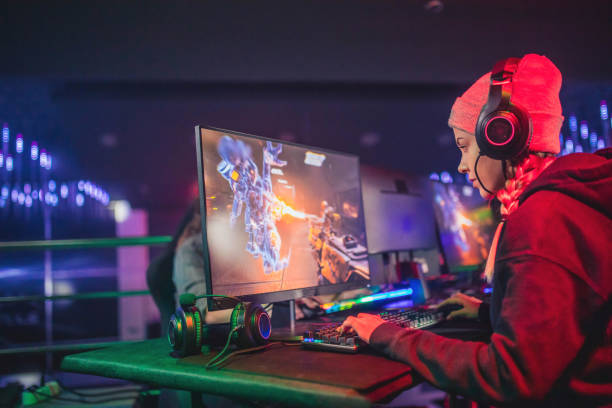Gaming has always been a weird little world where reality kinda bends. I mean, one minute you’re chilling on your couch eating chips, the next you’re in some dystopian wasteland fighting zombies with a sword that doesn’t even exist. But if you think that’s wild, hold on, because the future of gaming is stepping into a whole new dimension—literally. VR, AR, and whatever other letters tech geeks dream up next are slowly taking over, and honestly, it’s kind of mind-blowing.
Virtual Reality: Living Inside the Game
VR, or virtual reality, isn’t exactly new, but it’s finally hitting that sweet spot where it’s not just some clunky headset that makes you trip over your furniture. I tried VR a couple of months ago at this small gaming café, and I swear, it was like being teleported. One second I was sipping my coffee, the next I was on some alien planet dodging laser beams. My friend recorded the whole thing and posted it on TikTok. People were commenting stuff like “Bro you look like a flailing octopus” and “Send help.” Honestly, that’s the charm of VR—suddenly gaming isn’t just something you watch on a screen, you’re actually living it.
What’s wild is how quickly VR tech is improving. Eye-tracking, better graphics, even haptic suits that let you feel a punch in-game (yeah, that’s a thing now), are becoming real. And the price is slowly dropping too. Remember when VR was basically “for rich nerds only”? Now you can get a decent headset without selling your soul. This accessibility means more gamers, more content, more wild online reactions. Social media is buzzing with people showing off their VR fails and epic wins, and it kinda fuels a whole community vibe that’s unique.
Augmented Reality: Gaming Meets the Real World
If VR is about escaping reality, AR is kinda like bringing the game into your life. Pokemon Go was the OG example, remember that? People walking into traffic for Pikachu, streets full of gamers trying to catch virtual creatures—total chaos, but hilarious. But AR isn’t just about monsters; imagine fixing up your kitchen and seeing what a new fridge would look like as a hologram, or playing a co-op strategy game right on your dining table. That’s where things are heading.
AR gaming, in particular, is sneaky addictive because it makes the ordinary world exciting. Even your boring commute could turn into some epic quest if the tech catches up. And it’s not all fun and games; AR has serious potential for learning, training, even mental health. Some early studies suggest AR games can improve hand-eye coordination and problem-solving skills without making it feel like homework. That’s kind of genius, if you ask me.
The Social Side of Immersive Gaming
One thing I’ve noticed on Twitch and Discord chats is that these immersive games are changing how we interact. People aren’t just solo grinding in some dungeon anymore. They’re streaming, collaborating, trash-talking, and basically living online in ways that weren’t possible a decade ago. I was watching a VR escape room livestream last week where the players kept bumping into each other and laughing so hard I nearly spilled my coffee. It’s messy, chaotic, and perfectly human—exactly why it’s fun.
There’s also a mental shift. Some psychologists are already talking about “virtual socialization” as a thing, where meeting friends in VR is almost as satisfying as the real deal. I mean, maybe that sounds nerdy, but it’s also kinda cool. Think about your friend who lives across the country—you can hang out in a virtual world, play a game together, and feel like you’re actually in the same room. And don’t get me started on VR concerts… some of them are insane. People are dancing around their living rooms while their avatars throw confetti in the virtual crowd.
The Tech That Could Blow Our Minds
Now, here’s where it gets slightly sci-fi. Companies are experimenting with brain-computer interfaces, AI-generated worlds, even VR that adapts to your emotions. Picture a horror game that senses when you’re scared and ramps up the tension—yeah, that’s terrifying but kind of genius. Or AR glasses that give you hints in real life, like gamifying your morning jog. The lines between reality and gaming are blurring faster than memes on Twitter.
Of course, not everything is sunshine and unicorns. Some people get motion sickness from VR, there’s a ton of privacy stuff with AR tracking your surroundings, and, honestly, gaming addiction is real. But like any tech, it’s about balance. The hype is crazy, but the future doesn’t have to be a dystopian gamer nightmare. If anything, the direction is exciting, like a rollercoaster you can’t look away from.
Why This Matters
You might be thinking, “Okay, VR and AR sound cool, but why should I care?” Well, it’s not just about gaming. This tech is slowly creeping into education, work, social interactions, even therapy. Virtual meetings might one day feel less like staring at a pixelated Zoom square and more like actually being in the same room. Doctors are already using VR to train surgeons. AR is helping architects visualize buildings before they’re built. And for gamers, it’s about immersion, creativity, and community.

